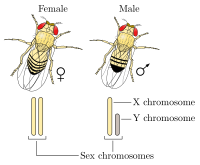
Photo from wikipedia
Neotropical Primates (Platyrrhini) show great diversity in their life histories, ecology, behaviour and genetics. This diversity extends to their chromosome complements, both to autosomes and to sex chromosomes. In this… Click to show full abstract
Neotropical Primates (Platyrrhini) show great diversity in their life histories, ecology, behaviour and genetics. This diversity extends to their chromosome complements, both to autosomes and to sex chromosomes. In this contribution, we will review what is currently known about sex chromosomes in this group, both from cytogenetic and from genomic evidence. The X and Y chromosomes in Neotropical Primates, also known as New World Monkeys, have striking structural differences compared with Old World Monkeys when Catarrhini sex chromosomes are considered. The XY bivalent displays a different meiotic behaviour in prophase I, and their Y chromosome shows extensive genomic differences. Even though the most widespread sex chromosome system is the XX/XY and thus considered the ancestral one for Platyrrhini, modifications of this sexual system are observed within this group. Multiple sex chromosome systems originated from Y‐autosome translocations were described in several genera (Aotus, Callimico and Alouatta). In the howler monkeys, genus Alouatta, an independent origin of the sexual systems in South American and Mesoamerican species was postulated. All the above‐mentioned evidence suggests that the Y chromosome of Platyrrhini has a different evolutionary history compared with the Catarrhini Y. There is still much to understand regarding their sex chromosome systems.
Journal Title: Journal of Evolutionary Biology
Year Published: 2022
Link to full text (if available)
Share on Social Media: Sign Up to like & get
recommendations!